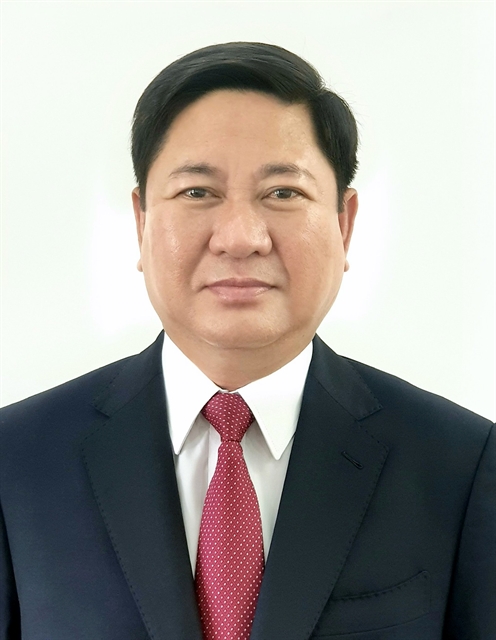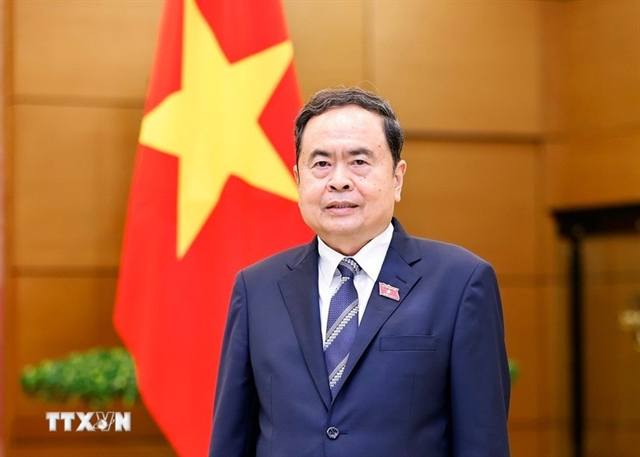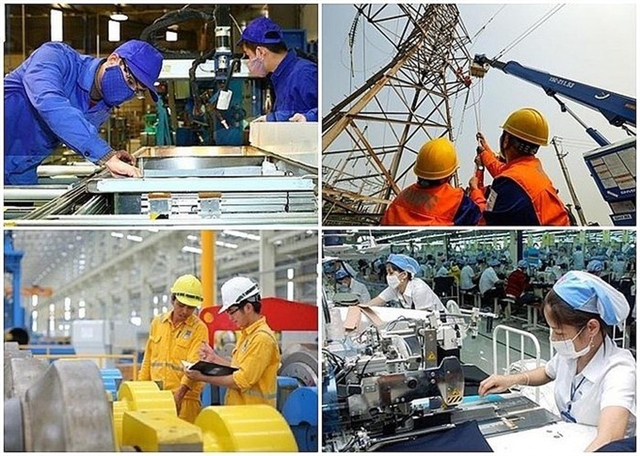 Society
Society

Thirty years is not a long time, but the headway that Ninh Thuận Province has made from a low economic starting point is worthy of respect. Trần Quốc Nam, chairman of the provincial People’s Committee, explains why in an interview with the Vietnam News Agency (VNA) on the 30th anniversary of the province’s establishment (April 1, 1992 - April 1, 2022)

|
| Trần Quốc Nam, chairman of the Ninh Thuận Province People’s Committee, shares some insights on the development journey of the province. VNA/VNS Photo |
Thirty years is not a long time, but the headway that Ninh Thuận Province has made from a low economic starting point is worthy of respect. Trần Quốc Nam, chairman of the provincial People’s Committee, explains why in an interview with the Vietnam News Agency (VNA) on the 30th anniversary of the province’s establishment (April 1, 1992 - April 1, 2022)
Inner Sanctum: Can you give us a broad outline of Ninh Thuận’s socio economic development from the early years of its re-establishment until now?
Over the past 30 years, Ninh Thuận Province has received support and timely guidance from the Central Government on building specific mechanisms and drafting policies. This has created a favourable legal corridor for economic development and generated resources for infrastructure investment. Given the opportunity to integrate into the national process of industrialisation and modernisation, Ninh Thuận has been able to thrive in recent years.
It is worthwhile noting the excitement, exhilaration and determination of authorities and people of Ninh Thuận in the early days of building the new province, promoting solidarity, seizing opportunities and creatively applying guidelines from relevant authorities. The enthusiasm and responsibility shown by generations of provincial leaders has made a significant impact as well.
Of course, the province has also encountered many difficulties, particularly the lack of synchronisation from provincial cadres in the early days. The province had a low and uneven economic starting point with big differences between the plains and the mountains, poor technical infrastructure, arid climate, low quality reservoirs, canals and other irrigation works, undeveloped industries and services (mostly small-scale production and businesses with low productivity and economic efficiency). It was also hampered by insufficient budget revenues. People were leading very difficult lives.
The province also faced several challenges in the process of construction and development, especially when the National Assembly cancelled the construction of two nuclear power plant projects, which affected implementation of the province’s socio-economic development goals.
Through seven congresses of the provincial Party Committee, from the Seventh Congress (1992-95) to the Fourteenth Congress (2020-25), various thematic resolutions with proper decisions have been made. Management among relevant authorities has become more flexible, creative and responsive with a high sense of responsibility.
Eventually, after 30 years of its establishment, Ninh Thuận has risen from one of the poorest provinces in the country to one that is thriving and looking to the future with confidence. Impressive development can be clearly seen during the past 10 years.
Between 2019 and 2021, Ninh Thuận was among the five provinces with the highest GRDP growth in Việt Nam. With economic restructuring happening in the right direction, the province was able to generate higher budget revenues to the latest figure of VNĐ4,343 billion.
The province’s per capita income has also increased rapidly, from VNĐ1.37 million to VNĐ68.4 million.
Total social investment has skyrocketed 441 times from VNĐ67.8 billion to VNĐ29,920 billion. Both urban and rural areas of Ninh Thuận have experienced positive changes with the embrace of the marine economy and renewable energy.
The province's technical infrastructure systems have been upgraded in a modern and synchronous manner and new urban areas formed. Socio-cultural values have developed comprehensively while education and health sectors have made great progress.
In short, both the material and cultural life of people in the province has improved continuously. National defence, security, political stability, social order and safety have been maintained. The province has also made gains in its foreign affairs work.
Inner Sanctum: Can you highlight some of the breakthrough factors that made this impressive growth possible?
In the last ten years, Ninh Thuận has improved its position and developed rapidly and sustainably. Taking strategic and planning advice from foreign consulting organisations, the province's authorities aim to turn disadvantages into competitive advantages – in other words, challenges into opportunities for development.
The focus on developing its renewable energy sources has created a breakthrough in boosting economic growth. Despite difficulties caused by the COVID-19 pandemic, the province's GRDP growth rate was ranked 4th in the country -- up 14.69 per cent in 2019, 10.02 per cent in 2020 and 9 per cent in 2021.
The economy was scaled up significantly, reaching VNĐ40,777 billion in 2021, an increase of 4.61 times over 2010. Total social investment reached VNĐ29,418 billion in 2020, 5.9 times higher than 2010.
Developing a long-term strategic vision has been crucial to Ninh Thuận’s growth. The province was the first to get approval from the Prime Minister to hire foreign consultants, namely Monitor Group of the US and Arup of the UK, to formulate a socio-economic development master plan until 2020.
To fulfil the vision, development orientation was based on the six pillars of industry, including four groups of basic industries – renewable energy, tourism, industry, agriculture, forestry and fisheries; and two groups of supporting industries – construction-real estate and education-training.
Besides, the province proactively switched its socio-economic development strategy from focusing on nuclear power plants to renewable energy, particularly wind power and solar power, in line with the planning orientation approved by the Prime Minister.
Synchronous investment in quality transport and irrigation infrastructure has been another factor in our success. A number of important transport routes such as coastal roads, ring roads and double roads connecting either end of the province have been constructed in order to boost Ninh Thuận’s socio-economic development.
Multi-purpose irrigation infrastructure has helped the agricultural sector thrive, introduced great efficiency in supplying water for daily life and production and addressed potential problems of natural disasters.
Inner Sanctum: The focus on renewable energy has been a major factor in the province’s development. Please tell us how this happened.
As I said earlier, in addition to the leadership and support from the Government, the enthusiasm and responsibility shown by several generations of provincial leaders resulted in identifying the right direction to achieve development breakthroughs.
Developing the energy industry as a driving force for economic breakthroughs and restructuring was one of the most significant policies thus initiated.
After the Government issued Resolution 115/NQ-CP on August 31, 2018, the province's difficulties and challenges became opportunities with competitive advantages. It enabled the attraction of investment and building Ninh Thuận into a national hub for renewable energy.
By 2021, the province had 49 renewable energy projects with a total capacity of 3,055.6 MW connected to the national grid, generating an output of 6,408 million kWh in 2021 and creating an added value of VNĐ3,614 billion, up 59.8 per cent over three years. This contributed to a 6.84 per cent growth of the province's GRDP in 2021.
The province also identified a lever to attract more investment, especially from FDI enterprises, domestic enterprises and the state budget. Investment capital from the budget was identified as "prime capital" to promote and attract investment. The province has always paid close attention to investment promotion, administrative reform and creation of an open, equal and transparent investment environment for domestic and foreign investors.
In 1994, there was only one FDI project in the province with a total capital of VNĐ24.5 billion. Today, we have 35 FDI projects with registered capital of VNĐ26,500 billion. Besides, we have 396 domestic investment projects with a registered capital of more than VNĐ161,000 billion, 307 of which have been completed and put into production.
Inner Sanctum: Given the context of the COVID-19 pandemic, what solutions or directions has the province identified to promote socio-economic development in the new period?
First, it is crucial to prioritise people and businesses’ benefits, continue to strongly reform admin procedures, improve the investment environment, enhance provincial competitiveness, implement solutions and measures to maintain and improve the PCI, SIPAS, PAPI, PAR indexes. We have to promote private sector development, perfect mechanisms and policies to attract investment, remove difficulties and obstacles in production and business, reduce recovery costs and expand business investment, among several other key measures.
Second, the province will continue its economic restructuring, boost application of science and technology in various fields, promote innovation, digital transformation and digital economy, and increase the competitiveness of the economy. Strategically envisioning Ninh Thuận as a "land of convergence of different values", the policy will focus particularly on potential industries with high competitiveness. Five industrial clusters: renewable energy and clean energy, tourism, manufacturing and processing industry, high-tech agriculture, and construction-real estate will be emphasised.
Third, the province will focus on developing dynamic economic zones such as the southern key economic zone to become a coastal economic zone for the whole country. It will ensure sustainable development of ethnic minority areas and mountainous areas and build a coastal tourism strip, transforming Phan Rang City-Chàm towers complex into a smart area. We will continue to invest in Tân Sơn Town; upgrade the Phước Dân and Khánh Hải urban areas; develop new urban centres of Cà Ná, Vĩnh Hy, Thanh Hải as well as the towns of Lợi Hải, Phước Nam and Phước Đại.
Fourth, Ninh Thuận will mobilise maximum resources to complete essential socio-economic infrastructure in the direction of high, compatible and modern connectivity. Investments in transport infrastructure, telecommunications, seaports, irrigation, urban areas, industrial clusters, power transmission, digital information, healthcare, education, culture and tourism will be key.
Fifth, the province will continue to train quality human resources, especially in key economic sectors; provide quality healthcare; create jobs; and promote sustainable poverty reduction. VNS




